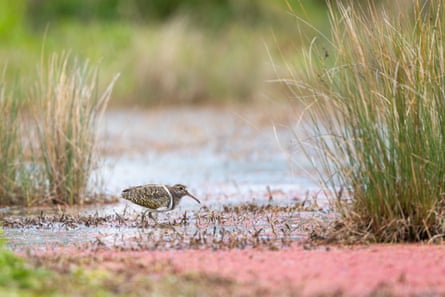“Near-mythical” is how the ecologist Matthew Herring describes the Australian painted-snipe – one of this continent’s rarest birds.
“Some of these terms get thrown around,” Herring says, “but they really are.”
It is believed there are only about 340 individuals left, but that’s not all that makes them rare. Australian painted-snipes exemplify the saying “out of sight, out of mind”. Even birdwatchers
with decades in the field forget they exist.
“They’re a super-sneaky, cover-dependent, mud-loving, waterplant-hiding shorebird,” Herring says.
A research project that correlated the evolutionary uniqueness of the world’s nearly 10,000 bird species against their conservation status, as a way of prioritising them, placed the Australian
painted-snipe at No 29.
“So it’s definitely a weird bird,” Herring says.
And an elusive one. It ranges across a vast area, from the Murray-Darling Basin to the Kimberley. Sightings are few and far between.
“From memory if you look at [the apps] Birdata and eBird over the last two years I think there’s five records across Australia,” Herring says.
With so few sightings, researchers struggle to fill in even the most basic knowledge about the painted-snipe – written with a hyphen to distinguish it from “true” snipes, to which it is
only distantly related. It’s not even clear why there are so few. Herring, who heads the consultancy Murray Wildlife,
says habitat destruction and introduced predators are likely to be playing a role, as well as extreme weather events caused by climate change – but in other parts of the world the South American painted-snipe and the greater painted-snipe of Asia and Africa
are doing OK.

Researchers hope to fit at least 12 painted-snipes
with satellite transmitters to learn more about them. Photograph: David Stowe
“Maybe the nature of Australia, maybe the ephemerality of [Australian] wetlands is less suitable for that particular organism that is a painted-snipe,” Herring says.
Herring describes the Australian painted-snipe as the wetland equivalent of the night parrot – but he points out that even the night parrot, which is so elusive that for
a century it was thought to be extinct, is better known to western science. Unlike the night parrot, there are no recordings of the Australian painted-snipe’s call.
Like many other Australian wetland birds, painted-snipes appear to be nomadic, but Herring says “they just vanish for months or years at a time”.
“And we don’t know where the strongholds are during winter or during droughts. It’s very hard to conserve a bird if you don’t know where they are for years at a time.”
Which is why Herring and his colleagues – a mix of shorebird experts from various universities and other organisations – have asked the public for help.
“We’re relying on all birdwatchers across the country and other people that are out and about in wetlands to report sightings to Birdlife
Australia and they’ll make their way back to us,” he says.
At the start of November Herring announced a crowdfunding campaign, hoping to raise $116,300 in 40 days. That would allow his team to fit at least 12 painted-snipes with satellite transmitters
and finally learn where the birds go for years at a time when they are out of sight.
.

The distinct patterns of the elusive Australian
painted-snipe. Photograph: David Stowe
It’s not the first conservation effort to turn to crowdfunding: in recent years researchers studying glossy-black cockatoos, Kangaroo Island dunnarts, swift parrots and many more have
asked for public assistance. Herring himself led a previous crowdfunding effort for Australasian bitterns.
Prof Euan Ritchie, a wildlife ecologist at Deakin University, says it should not be left to the public to fund research on endangered species.
“Australia is an exceedingly rich nation, but when it comes to the conservation and care of our life-supporting ecosystems and globally unique wildlife, far too often there is little to
no financial support from governments,” he says.
In October the environment minister, Tanya Plibersek, said
the government was committed to ending Australia’s extinction crisis, but it remains to be seen how
it will fulfil that pledge.
Ritchie says: “Australia’s governments can seemingly afford $250bn in tax cuts for the rich, more than $100bn for new submarines and $10bn per annum for fossil fuel subsidies.
“Chronic underfunding of conservation not only places our natural wonders at further risk of decline, or at worst, oblivion, but it fails to capitalise on the enormous social, cultural,
economic and environmental opportunities of investing in recovering and sustaining nature.”
Herring admits there is a certain amount of crowdfunding fatigue.
“I swore I’d never do it again … but we were forced down this track really. It’s urgent. You can run a campaign and you can be ready to buy transmitters and send people out into the field
immediately, and a lot of research grants can take six months or a year, sometimes even longer. Crowdfunding has that urgency about it, which is great.”
The campaign reached its goal on 18 December, with four days to go, thanks to donations from more than 250 people. Many had probably never heard of painted-snipes before.
“And that’s one of the real benefits of crowdfunding,” Herring says. “That makes me feel good.”
In the context of Australia’s – and the world’s – extinction crisis, we need all the feelgood stories we can get.
Vanishing bird: the mystery of the ‘near-mythical’ Australian painted-snipe | Birds | The Guardian

